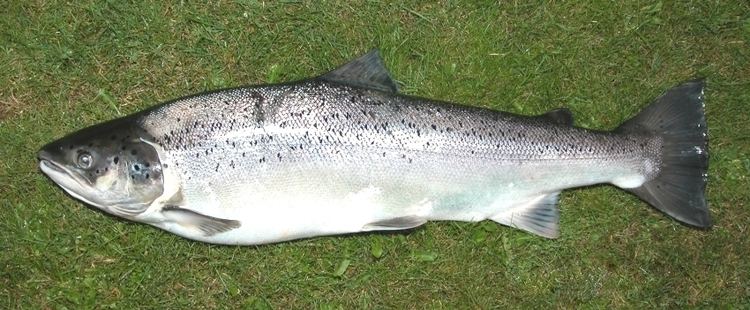Scientific name Salmo trutta trutta | Phylum Chordata Order Salmoniformes Genus Salmo Rank Subspecies | |
 | ||
Similar Brown trout, Atlantic salmon, Grayling, Northern pike, Arctic char | ||
Sea trout is the common name usually applied to anadromous (or sea-run) forms of brown trout (Salmo trutta), and is often referred to as Salmo trutta morpha trutta. Other names for anadromous brown trout are sewen (Wales), peel or peal (SW England), mort (NW England), finnock (Scotland), white trout (Ireland) and salmon trout (culinary). The term sea trout is also used to describe other anadromous salmonids--coho salmon (Oncorhynchus kisutch), brook trout (Salvelinus fontinalis), Arctic char (Salvelinus alpinus alpinus), cutthroat trout (Oncorhynchus clarkii) and Dolly Varden (Salvenlinus malma). Even some non-salmonid species are also commonly known as sea trout--Northern pikeminnow (Ptychocheilus oregonensis) and members of the weakfish family (Cynoscion).
Contents
Range
Anadromous brown trout are widely distributed in Europe along the Atlantic and Baltic coasts, the United Kingdom and the coasts of Iceland. They do not occur in the Mediterranean Sea but are found in the Black and Caspian Seas? and as far north as the Barents and Kara Seas in the Arctic Ocean. Brown trout introduced into freshwater habitats in Tasmania, Victoria, New Zealand, Falkland Islands, Kerguelen Islands, Chile and Argentina have established anadromous populations when there was suitable access to saltwater. Anadromous behavior has been reported in the Columbia river and its tributaries in the U.S. and in Canadian rivers on both the Pacific and Atlantic coasts.
Taxonomy
As treated here, the anadromous sea trout Salmo trutta morpha trutta is not taxonomically distinct from the freshwater-resident forms of the brown trout, i.e. the lacustrine S. t. morpha lacustris and the riverine S. t. morpha fario, although previously they have been considered different subspecies or even species. They represent ecological forms with different migration behaviour. - Originally the name Salmo trutta was used to refer specifically to the anadromous or sea-run forms of brown trout. Early angling literature often referred to sea trout as white trout or bull trout.
Description
Anadromous brown trout are a silvery color with faint black spots. However, once they return to freshwater they quickly take on the normal coloration of resident brown trout in preparation for spawning. Sea trout kelts (post spawn) return to their silvery stage as they migrate back to saltwater. Adult brown trout are between 18 to 56 centimetres (7.1 to 22.0 in) long, and can weigh from 9 to 24 kilograms (20 to 53 lb). Breeding males will develop a hook-like, upward-facing protrusion on the lower jaw called a kype. In freshwater the top of the trout is an olive color with brown and black spots with the ventral side being tan to yellow. The sides have many orange and red spots ringed with a light blue.
Lifecycle
Their average length is 60 cm, but they can grow up to 130 cm in length and weigh up to 20 kg under favourable habitat conditions.
Their most striking feature is the long, elongated, torpedo-shaped body. They have silver grey sides and grey-green backs. The belly is white. Like all trout species the sea trout has an adipose fin.
Sea trout feed mainly on fish, small crabs, shrimps and prawns.
It is an anadromous, migratory fish, which closely resembles the Atlantic salmon in its form and lifestyle. In the sea, it makes long journeys and also swims upstream into small rivers in order to spawn. Spawning occurs in winter on gravelly river beds in the grayling zone to the barbel zone. Their eggs are laid in troughs or redds. The young fish remain in freshwater for one to five years and then make their way to the sea. The "inner clock" signals to the fish when they need to make their return journey to the sea. During this migration, they can cover up to 40 km per day.
Fish that are ready for spawning are usually lean and have to eat a lot of food in order to increase their energy levels as quickly as possible. After completion of the spawning process, the fish return to the sea. Mass mortality after spawning, as is common in some species of salmon, is not usual. Once back in the sea, the fish regain their weight and lose their brown spawning colouring.
Threats
In many rivers of Central Europe, the sea trout have been extirpated because hydropower plants prevent spawning migration. In addition, many spawning grounds have disappeared due to the backflooding of rivers. In more recent times, sea trout have succeeded in re-establishing themselves in some lakes and rivers through the introduction of fish ladders and bypass channels around hydropower plants. In this way spawning migration has been enabled again, albeit in a limited way.
Angling
Sea trout are popular with anglers and as food. The close season lasts at least three months depending on river authority regulations. Like salmon, sea trout are protected by law in the Rhine river system and in most German rivers (except some northern German rivers) all year-round.
In the coastal waters of Schleswig-Holstein, sea trout is protected from 1 October to 31 December. This applies only for fish in spawning colour (brown), the silver coloured fish may continue to be caught. In most estuaries angling is completely prohibited in a protected area of 200 metres around the river mouth during this time.
In the coastal waters of Mecklenburg-Vorpommern, there is a general prohibition on fishing for sea trout from 15 September to 14 December. This applies both to fishermen and anglers.
In Germany, the term Absteiger is used by anglers to describe a sea trout after spawning. The removal of absteigers is a controversial topic among anglers. Most anglers refuse to take sea trout that have spawned because their meat is inferior and dry.
